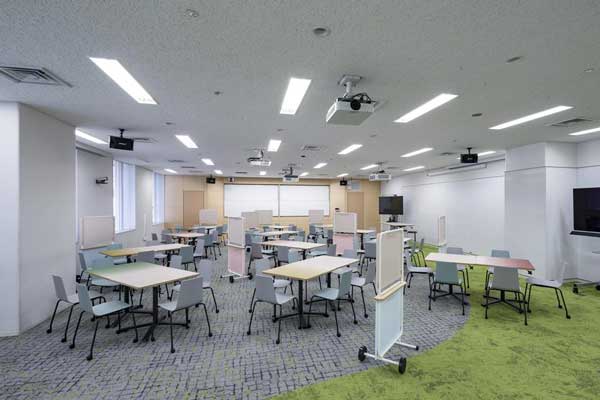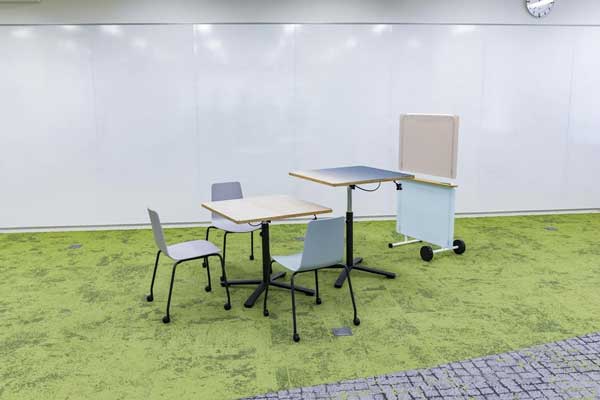A space imbued with the essence of an ecosystem
KOKUYO × KMD “Classroom of the Future”
Since its establishment, KMD has done away with the typical divisions of traditional laboratories, and worked to create a culture and environment which will inspire faculty and students alike.e Now, KMD is reinventing the very concept of the educational space of the classroom.
T “We wanted to create a space unlike what we conceive as a classroom. A space that changes human thought and behavior patterns,” says Professor Masa Inakage. It is with this desire in mind that Prof. Inakage approached the world-renown stationery company KOKUYO. “We are concerned with all aspects of the environments in which human bodies interact with, such as the stationery and furnishings,” recalls Takahiro Ishizaki at the KOKUYO TCM Head Office. “We believe that working and learning styles are important in these contexts, so this talk of creating the classrooms of the future really resonated with us.”
According to Atsuko Saito of the KOKUYO Workstyle Innovation Department, in the last 10 years corporate office spaces have gotten the jump on educational institutionss. She says that the aim to create spaces where you “wish to spend time and have fun” is not confined to IT or venture companies, but is now embraced by all kinds of businesses.
A discussion on what the classroom of 2030 will bring, while sharing innovative case studies of such endeavors.
In this era where remote learning is a reality, we have reassessed the significance of congregating in one place to learn. We have concluded that what is important for the classrooms of the future is an environment in which both educators and students can collaborate and innovatey. To that end, our focus turned to the effects of relaxation and physical movement. The concept of such spaces is “biophilia,” the innate human tendency to seek connections with nature and other forms of life. In natural ecosystems the same colors and shapes do not repeat themselves, so by incorporating this concept we conceived of an environment that doesn’t dictate where people stand or sit which facilitates discussions of a non-hierarchical nature.
Seeing the luscious sketches of Mr. Hiroshi Tokuyama from the KOKUYO Furniture Business Head Office was a true eureka moment. There is no pre-defined front of the classroom, and you can enter and exit from any side. The entire wall is a whiteboard, and you can use two sides for projection. The furnishings are placed on carpeting which evokes landscapes, and these can easily be moved to allow infinite combinations of standing and seating positions. Even the heights of seating can be adjusted. Care has been taken to ensure that surfaces retain the natural appearance and textures of wood.
Early returns are getting positive feedback from botht faculties and students, as they acclimate to using the space. However, we are far from finished – we will continue to listen to feedback and make improvements to the space, including finding new ways of incorporating digital and media technology.
KOKUYO Co., Ltd.
TCM Marketing Department, TCM Head Office
Takahiro Ishizaki
Workstyle Innovation Department, KOKUYO Co., Ltd.
Atsuko Saito
Furniture Business Head Office, KOKUYO Co., Ltd.
Product design group, Innovation Center, MONOZUKURI Division,
Hiroshi Tokuyama
(This article was written in March 2021.)
Carpets designed with the image of a landscape and mov- able furnishings that can be moved to allow free modifica- tions of the standing positions of teachers and students and the heights of seating.

